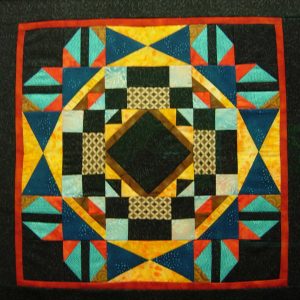Hyla Stories
A Journey through Art and Geometry
Long before Hyla math teacher Chris Johnson knew the exact shape and focus of her sabbatical project, she knew where she’d find her inspiration.
“I knew for years my sabbatical project would be in my studio—for me, that’s home,” said Chris.
Chris’s studio is a 400 square foot, light-filled room built above her garage on Bainbridge Island. Rather than scattered with paints and clay, it’s full of fabric, thread and sewing machines. Two large white walls, or “quilt walls,” enable her to hang her creations, step back and evaluate the designs.
Since embarking on her sabbatical year in fall 2010, Chris has spent 60 percent of her time teaching and 40 percent in her studio, pursuing a multi-faceted art project rooted in the history and beauty of quilt making. Inspired by references like “Hidden in Plain View,” by Jacqueline Tobin, a book showing how quilt block designs may have signaled clues to slaves on the Underground Railroad, and “Kaleidoscope Quilts,” a book by Paula Nadelstern about rotating and reflecting quilt patterns, Chris has developed a series of three fabric art pieces. Each appears to be a separate design, but is actually an outgrowth or “iteration” of the one before it. Through pattern and color each design mirrors the movement of a kaleidoscope.
“The way things move with a kaleidoscope is that you physically jiggle it or rotate the eye piece, but here, they’re moving mathematically, by reflection,” explained Chris.
The strong connection between quilt design and math first struck Chris nearly fifteen years ago when she took her mother to an annual quilt show in Poulsbo. Surrounded by the visual display of quilt designs, she thought instantly, “Oh my gosh, it’s all geometry.” Immediately she signed up for a class on quilting and for the first time she became acquainted with a color wheel.
“I learned how percentages of colors can make one tone dominate and another recede, and what colors work together to create a pleasing palate. This fascinated me. I was hooked.”
For her sabbatical project, Chris knew she wanted to do something with quilts, something with math, and she wanted it to be unique. She began by selecting two established quilt blocks from history: “Mollie’s Choice” from 1897 and “Garden Walk,” from 1940. Using EQ5, a software program designed for quilters to simulate designs, Chris married the two quilt block designs and arranged them into a secondary pattern. Then she selected a color scheme. From there she transferred the computer-generated design to actual fabrics, mocking up a 3X 3 quilt block design. This, however, is when she hit a wall.
“It was awful. After putting the quilt design into fabric, suddenly it was not at all what I envisioned,” said Chris. “It was flat and uninteresting. Nothing was working and I was just getting started.”
Leaving the mock up on the quilt wall, Chris went to teach a couple of classes and shared with the students how frustrated she was with her efforts.
“We talked about how it’s important to try different ways to solves problems,” said Chris. “You have to find your own way to think about it. I may like an idea but when it’s not working I have to re-examine the method and find a new way to approach it.”
When she went back to her studio she took a new approach. Lifting the center section out of her failed design, she redrew only this portion into the computer. Then she “denuded” it – stripping it of color and leaving only its geometric shapes. This enabled her to better see relationships of pattern and shape that might be enhanced through shades of color. With this new perspective she began filling in color schemes, 50 of which she saved into the computer. One of these she continued to refine before progressing to the fabric mockup – this time with success.
“I thought, oh wow, its creating a pleasing effect,” said Chris. “I began to see how the pieces resembled a kaleidoscope image. with 90 degree rotational symmetry and lines of reflection symmetry.”
Chris named the piece “Generation 1”, the first of her three art pieces. Mirroring the same design process, she went on to create “2” and “3.” None of the designs are intended to become full sized quilts, but to exist “as pieces of fabric art based on quilts,” said Chris.
Reflecting back on her experience, Chris said she expanded her reparatory of problem solving and has a renewed sense of helping students find their window into math.
“I saw what was hidden within; this is not unlike mathematics. Often people tend to go just for the answer but it’s much more interesting to look for the patterns and relationships, and to ask, what’s going on here? That’s how I teach math.”
Deeply appreciative of her sabbatical experience, Chris said the program allows teachers valuable and cherished time. “It’s a gift from the community that says take some time, nurture your own interests and be a learner.”
When working on a worthwhile project, the process of discovery and learning about oneself is the most gratifying part, according to Chris. “The product is simply the outcome of the learning curve, not the most critical part,” she said. “This reflects my teaching philosophy and belief about learning.”



